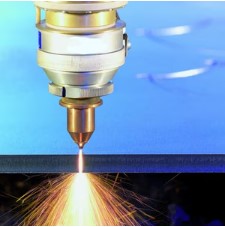Laser cutting machines have revolutionized the way we cut and shape materials across various industries, offering unparalleled precision, speed, and versatility. This technology relies on the use of highly focused laser beams to cut through a wide range of materials, from metals and plastics to textiles and wood. In this article, we will explore the principles behind laser cutting, its diverse applications, the advantages it offers, and the latest advancements in the field.
How Laser Cutting Machines Work
Laser cutting machines are based on the concept of laser technology, which stands for “Light Amplification by Stimulated Emission of Radiation.” The fundamental components of a laser cutting machine include:
- Laser Source: The heart of any laser cutting machine is the laser source itself. These sources can be of various types, including CO2 lasers and fiber lasers. CO2 lasers are well-suited for cutting non-metallic materials, while fiber lasers excel in cutting metals.
- Laser Resonator: The laser beam is generated and amplified within the laser resonator, which typically comprises mirrors and a laser tube. The mirrors maintain the beam’s intensity and focus it to a precise point.
- Optical System: The optical system includes lenses and mirrors to guide and focus the laser beam onto the material being cut. The focal length of the lens and the alignment of mirrors are crucial in achieving high precision.
- CNC Controller: A Computer Numerical Control (CNC) system is responsible for controlling the movement of the laser cutting head and the positioning of the workpiece. Operators use computer software to program the cutting path and set various parameters.
- Work Surface: The material to be cut is placed on a work surface, often a cutting table equipped with features like a grid or suction to secure the material in place and remove debris.
Applications of Laser Cutting Machines
Laser cutting machines find applications in a diverse range of industries due to their adaptability and precision. Some key applications include:
- Metal Fabrication: Laser cutting is extensively used in metalworking, enabling precise cutting of various metals such as steel, aluminum, and titanium. This is crucial in the production of automotive parts, aerospace components, and machinery.
- Signage and Artwork: Laser cutting is ideal for creating intricate designs in materials like acrylic, wood, and metal. This makes it popular for crafting signage, artistic installations, and custom decorations.
- Electronics: In the electronics industry, laser cutting is employed for cutting and engraving circuit boards, semiconductor materials, and small precision components.
- Textiles and Apparel: Laser cutting machines are used to cut fabric and textiles, offering clean edges and intricate patterns for clothing and upholstery production.
- Medical Devices: The medical industry utilizes laser cutting for manufacturing surgical instruments, stents, and various medical components, where precision and hygiene are critical.
- Automotive Manufacturing: Laser cutting plays a vital role in automotive manufacturing, producing components like chassis, body panels, and exhaust systems with high accuracy.
- Aerospace Industry: The aerospace sector relies on laser cutting for intricate, lightweight components in aircraft and spacecraft, where weight reduction is crucial.
- Architecture and Construction: Laser cutting technology is employed to create architectural models, intricate facades, and decorative elements in construction.
Advantages of Laser Cutting Machines
Laser cutting machines offer several advantages that make them indispensable in various industries:
- Precision: Laser cutting can achieve micron-level accuracy, ensuring that the final product meets tight tolerances and quality standards.
- Speed: Laser cutting is a high-speed process, significantly reducing production time compared to traditional cutting methods.
- Versatility: These machines can cut a wide range of materials, from metals and plastics to ceramics and composites.
- Minimal Material Waste: Laser cutting produces minimal waste as the heat-affected zone is small, and the cutting path can be optimized to minimize scrap.
- Intricate Designs: Laser cutting allows for intricate and complex designs that would be challenging or impossible with other cutting methods.
- Non-contact Process: Laser cutting is a non-contact method, meaning it doesn’t subject materials to mechanical stresses, preserving the integrity of the material.
- Clean Edges: Laser-cut edges are clean and require minimal post-processing, reducing the need for additional finishing steps.
- Automation Compatibility: Laser cutting machines can be integrated with automation systems for continuous, unattended operation.
Recent Developments in Laser Cutting Technology
The field of laser cutting continues to advance with ongoing developments driven by research and industry demand. Some of the recent advancements include:
- High-Power Fiber Lasers: There has been a trend toward higher power fiber lasers, enabling faster cutting speeds and the ability to cut thicker materials.
- Integrated Vision Systems: Some laser cutting machines now incorporate vision systems that can scan and adapt to irregularly shaped materials, improving accuracy.
- Hybrid Laser Systems: Combining laser cutting with other technologies, like waterjet cutting or plasma cutting, allows for more versatile and cost-effective cutting solutions.
- Industry 4.0 Integration: Laser cutting machines are increasingly being connected to the Industrial Internet of Things (IIoT) for real-time monitoring, predictive maintenance, and data-driven optimization.
- Eco-Friendly Features: Manufacturers are focusing on energy-efficient lasers and systems to reduce environmental impact.
- Additive Laser Manufacturing: Combining laser cutting with additive manufacturing techniques allows for more complex and customized parts production.
- AI and Machine Learning: These technologies are being used to optimize cutting paths and parameters, further improving efficiency and precision.
Laser cutting machines have unquestionably transformed the manufacturing landscape with their precision, speed, and versatility. As technology continues to advance, we can expect even more innovative applications and improvements in laser cutting machines, making them an integral part of modern industry across the globe.




